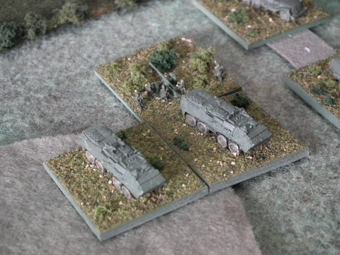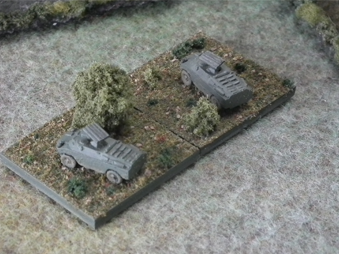

This page last modified: 13 November, 2013 (OT-62D updated)



The OT-810D mounted a BzK vz.59 heavy recoiless rifle which could be dismounted, like the one taking cover behind a hedgerow-enclosed field to the right. My OT-810D stands are made by modifying standard H&R OT-810 vehicles. I file the rear of the vehicle to flatten it out somewhat (although getting it to the proper profile would require more extensive surgery), and cut out some thin plasticard sheeting to make the raised superstructure, which encloses the gun on 3 sides (in real life, these could be hinged down to allow the weapon to traverse over a wide angle). The gun is just a wire rod, with crewmen added, typically from the WWII Soviet standing artillery crew strip.
Starting from the late 1960s, each Motor Rifle battalion had six
OT-810Ds (although some sources say only two), which were still being fielded surprsingly late into the 1980s - even the 20th Division, the army's foremost Motor Rifle unit, was still using OT-810Ds until 1986. The OT-810 chassis became available for conversion into anti-tank vehicles in the 60s when they were replaced in the APC role with the OT-64; others were converted into ambulances, or commander's or artillery observer's vehicles. In these roles, they served until the mid-90s.

Shown above is another kind of battalion-level anti-tank system: the OT-62D. An OT-62D is simply a standard OT-62 with a BzK vz.59 mounted on the back deck, and a couple of extendable ramps so the thing can be rolled off the pack and dismounted if required; in other words, a portee mount. A very similar porteed gun system had been tried out by the Soviets with the earliest BTR-50 model; unfortunately the open troop compartment of the early BTR-50 meant the gun's firing caused severe concussion to the occupants! Later models scrapped the ramps needed to dismount the gun, and the portee system was not reintroduced when the BTR-50PK, with its closed troop compartment, was introduced.
The Czechoslovakian OT-62D was introduced at the end of the 60s; the OT-62 itself having been in service fom 1963. It didn't last as long in service as the OT-810D did, because when the OT-62-equipped regiments switched over to the BVP-1 (i.e. BMP-1), battalion-level AT assets were considered to superfluous given the Sagger ATGWs each BVP carried. I made the barrel of the BzK with a wire rod, it was mounted on another piece of wire as an axle. The wheels, plus the trailing support arm, come from the BM-14 towed MRLs that I cut up when making my vz.51 MRLs. The crew are from the WW2 Soviet Artillery Crew (kneeling) pack.



Above is the regimental anti-tank company from the OT-equipped 4th Motor Rifle Regiment. The left-hand OT-64 dismounts as an AT-3 stand (you can just make out a couple of Saggers sitting on the roof, waiting to be dismounted), while the right-hand one is towing a BzK vz.59 recoiless anti-tank gun. The regimental anti-tank companies were 9 vehicles strong in 3 platoons of 3, presumably so that one platoon could be allocated to each fighting battalion, but as is usual in MSH, Soviet doctrine isn't very well catered for, as this gets translated into 2 stands on the table-top.
This company models the post-1979 organization applicable to a
2nd-echelon OT-equipped formation as the 3rd Motor Rifle Division's
4th Motor Rifle Regiment was. BVP-equipped regiments and 1st-echelon
OT-equipped regiments were instead equipped with 9P133 (BRDM-2/Sagger),
which are definitely more effective on-table simply because they are
entirely Saggar-equipped instead of half of them lugging around obsolete
anti-tank guns. Of course even Saggers aren't much to write home about;
the only 9P148 (AT-5-equipped) vehicles in the Czechoslovkian army (a
grand total of 32 of them) were found distributed amongst 6 army-level
anti-tank units with either 4 or 6 partially replacing 100 mm AT guns in
each battalion.

Here's the previously-shown regimental anti-tank company dismounted. This is an alternative arrangement for the company. In the previous photo, the ATGWs and the AT RRs were depicted in separate vehicles, so they could deploy separately, as is realistic given their different combat roles: guns to the fore, Saggers behind them in over-watch. However, in reality, like other WarPac AT sections (which instead had the SPG-9 and Sagger combination), these were transported together rather than separately, so integrating them on a single stand is also a valid representation, and this is what's shown in this shot (of course, the BzK, unlike the SPG-9, was too much big to be carried internally, so was towed behind the APC rather than carried in it).
In terms of game stats, I reduce the attack factors of the integrated
stands, since they have only half as many weapons per stand, but they do
get both an AT factor and an ATGW factor, in this case 6 rather than 7
AT, and 2 rather than 3 ATGW. Which is "better" really depends on the
situation. Against lightly-armoured vehicles, you are usually better of
with integrated stands, as numbers of shots counts more than quality,
but against decent armour, the Saggers are often better off combined in
a single stand to get that higher ATGW factor. Of course, you need to
choose this before the game begins, especially if you are using a points-based system like Keith
McNelly's.

A battery of 9P148 vehicles - these are BRDM-2 armoured cars equipped with AT-5 Spandrel launchers. This is as good as (ground-based) anti-tank weaponry gets for the Czechoslovakian army. Unfortunately, they only entered service in... 1985, long after the Soviets get them. So by the time you can field them, any opponent is likely to be fielding M1s or Leopard 2s that can pretty-well much ignore them anyway! (A basic early-80s M1 Abrams or Leopard 2 has a CED of 5 (gulp!), whereas an AT-5 has an ATGW factor of 4, so you can't even kill them outright, only supress them...)
But that's not the worst of it, because for Czechoslovakia, the 9P148
isn't a Regimental-level asset like it is for the Soviets, or even a
Divisional-level asset, because the entire Czechoslovakian military had
a grand-total of 32 of them! Consequently, they are an Army-level
asset. The 4th Army, to which the 3rd Division belonged, had half of
them, organized into three batteries, one of which was 4-vehicles strong (a
single MSH stand), and two of which were 6-strong (i.e. 2 MSH stands if
you are being generous, 1 if not...). These three batteries were
allocated one per battalion of the Army's 217th Anti-Tank Regiment (the
remaining batteries in each battalion were towed 100 mm AT guns). So
pretty-well much two stands maximum for any conceivable table-top force.

And here is the poorer cousin of the 9P148, the 9P133, also known as BRDM-2 with AT-3 Sagger in NATO-speak. Being dedicated AT vehicles, these have an ATGW factor of 3 instead of the factor 2 that BVP-1s have, despite both being armed with the same weapon: the 9P133 has more rounds to fire; it has multiple launchers meaning less time (or none) is spent reloading; and its crew aren't infantry with a side-job of being missile jockeys; they are full-timers.
This is a reasonable model. Fairly crisp casting, with no major flaws, but also
nothing that grabs me and says "nice". In game terms, they are vey useful if
you are facing an enemy with lots of DEF 2 tanks, like Chieftains or M60s, but
utterly useless if facing things like M1s or Leopard 2s, in which case you'd be
better off taking 6 machine-gun armed scout cars (that cost the same amount of points) and
hoping for lucky suppression hits...

This base isn't part of my Czechoslovakian force: it represents a Soviet (or Polish or Hungarian...) Motor Rifle Battalion-level anti-tank platoon equipped with AT-4 Spigot launchers (the two guys to the left) and SPG-9 recoiless gun systems (the three guys to the right). In real life, such platoons typically had 4 Spigot teams plus 2 SPG-9 teams, carried in BTRs. Because a Spigot arms itself almost immediately after leaving its launching tube, none of these team members carry RPG-7s. The equivalent Sagger-equipped teams also had to have some guys equipped with RPGs to cover the 500 m or so of dead ground between the Sagger launcher an the position when it could be successfully armed and aimed onto a target, so the platoons were deployed in three layers - RPG men to the fore, then SPG-9s, with the ATGWs well to the rear. This isn't really simulatable with a single stand of course, but that's perhaps of no real concern in a game that operates at the scale MSH does.
The Czechoslovakians stuck with their BzK vz.59 recoiless rifle in place of the SPG-9, despite the BzK being much heavier (the SPG-9 is theoretically man-portable, but in practice, is carried in a vehicle, because, once you include its tripod, it weighs about 60 kg), and not all that much better in terms of performance, because the SPG-9 fires an exceptionally large (and thus long) munition given its 73 mm bore, enabling it to pack a lot of explosive into the warhead.

Now if you think this shot looks very similar to the previous one, you'd be right! The only difference is that, in this shot, the SPG-9 is scratch-built from four pieces of 0.5 mm wire, whereas the previous one shows the commercially available H&R SPG-9 model. I think my one looks pretty good, actually... Now normally I wouldn't bother scratch-building something when a commercial model is available from H&R, but the H&R one is very hard to get hold of. It's only available, as far as I can tell, as part of the Soviet Airborne pack, and each pack contains just a single example. And since I only needed a single pack of paratoopers to give me enough men to model an entire Czechoslovakian paratoop battalion, I wasn't going to buy 50-odd more paratroopers every time I wanted to buy an SPG-9 to model some other WarPac units; so instead I made a couple of my own. It was pretty easy, so I might make some more up in the future, but now that I have 3, that's enough for a regiment of infantry, which is probably enough for now.

Back to my photos top page.